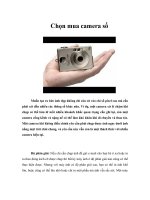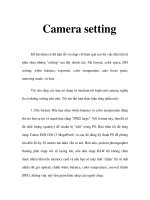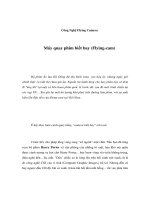E03 Camera Basics ISO Speed
Bạn đang xem bản rút gọn của tài liệu. Xem và tải ngay bản đầy đủ của tài liệu tại đây (989.08 KB, 9 trang )
Camera Basics
ISO Speed
ISO speed plays an equally important role as aperture and shutter speed in
its effect on exposure. Now let us learn more about the advantages and
disadvantages of turning up the ISO speed
In a low light environment, we can increase the shutter speed by
turning up the ISO speed
Points-to-note
- W ithin Normal ISO speed range, the lower the ISO speed, the higher the
image quality.
- Increasing the ISO speed allows the camera to set a faster shutter speed.
- Noise occurs at higher ISO speeds.
To put it simply, ISO speed is the image sensor’s capability to sense light,
reflected as a numerical value. It is said that exposure makes or breaks a
picture, but ISO speed is also a major factor in determining exposure.
If aperture is the width of the light ray passing through and shutter speed is
the time taken for the light ray to pass through, then ISO speed describes
the image sensor’s capability in sensing light. The higher the value, the
more sensitive the camera to light. Even under dark environments or when
taking pictures of night scenery, we can still take good, bright pictures. In
other words, assuming that we don’t need the image to be brighter, a higher
ISO speed makes a faster shutter speed possible. Simply b y adjusting the
ISO speed, we increase the shutter speed. By doing so, we can prevent the
blurring that results from camera shake or subject motion blur.
A higher ISO speed also allows us to achieve a narrower aperture without
compromising on image brightness, as long as we use a fixed shutter speed
(such as by using Shutter-priority AE mode).
As much as I am saying that ISO speed is such a useful function, it has its
disadvantages too. The higher the ISO speed, the more noise it generates.
The overall image comes up grainy. Yes, there are cameras with noise
reduction features around, but most photographers will still try their best
keep the ISO speed to a setting that does enough to prevent blurring from
camera shake. Usually, this is as close to t he base ISO speed (lowest
Normal ISO speed) as possible, but may be higher depending on
photographic intent and shooting conditions.
For instance, you might be able to get away with base ISO speed
when photographing light trails and buildings at night. However, you would
need a higher ISO speed to prevent camera shake when shooting handheld
at night. And if you want to capture stars in your shot, even if you use a
tripod, you will certainly need both a slow shutter speed a nd a very high ISO
speed.
From left:
EOS 5D Mark III/ EF50mm f/1.4 USM/ FL: 50mm/ Aperture -priority AE (f/5.6,
2.5 sec, EV-0.7)/ ISO 100/ WB: Auto
EOS 5D Mark III/ EF50mm f/1.4 USM/ FL: 50mm/ Aperture -priority AE (f/5.6,
1/6 sec, EV-0.7)/ ISO 1600/ W B: Auto
EOS 5D Mark III/ EF50mm f/1.4 USM/ FL: 50mm/ Aperture -priority AE (f/5.6,
1/50 sec, EV-0.7)/ ISO 12800/ WB: Auto
Notice how the noise in the image increases as higher ISO speeds are used.
Depending on the situation, things might turn up very conspi cuous. Make
sure you do not turn ISO speed up too high!
When moving from a bright environment to a dark one, remember to turn up
the ISO speed, otherwise there will be a risk of camera shake. If you think
you may forget, you can leave the camera in ISO AUTO mode. This is a
convenient feature that automatically adjusts the ISO speed on the camera
so that the shutter speed setting will be fast enough to prevent camera
shake. It can also prevent the camera from using the same high ISO speed
to take photos even after you have shifted to a bright environment from a
dark one.
The ISO AUTO screen
When setting ISO AUTO, select [AUTO] on the screen for setting. When
AUTO is selected, the camera will automatically determine the ISO speed
according to the scene and the picture mode. This is a very convenient
feature that helps stabilize the image when there is camera shake and
subject motion blur.
Setting the upper limit for ISO AUTO
When setting the ISO speed to AUTO, it is also possible set the upper limit
of the speed that the camera can operate at. If the upper limit is set higher,
even though it can take pictures easily during dark scenes or with dark
subjects, there will be more noise. Set the ISO speed to something that will
not affect the image quality too badly.
Useful tip: The difference between Normal ISO speed and Expanded ISO
speed
Some cameras differentiate between Normal ISO speed and Expanded ISO
speed. “Normal ISO speed” ( also known as the "native ISO speed") refers
to an ISO speed range that the camera manufacturer has tested and deems
should give you optimum image quality. “Expanded ISO speed” refers to a
speed higher or lower than the Normal ISO speed range, and typica lly will
result in some form of compromise in image quality when you use it. When
deciding when to use which, take the purpose and subject of the shoot into
consideration. If image quality is important for the situation, it is
recommended that you work within the Normal ISO speed range.
Expanded ISO speed setting screen
On most cameras, Expanded ISO speed is turned off by default. Some
cameras allow you to set an expanded lower ISO speed in addition to an
expanded higher ISO speed.
Noise Reduction setting screen
Nosie Reduction lowers the effect of noise when doing high ISO speed or
long exposure shots. Select the right level according to the scene.
![12 cách chọn ISO [độ nhạy sáng] thích hợp nhất khi chụp ảnh](https://media.store123doc.com/images/document/13/gu/zd/medium_zdi1376624678.jpg)








